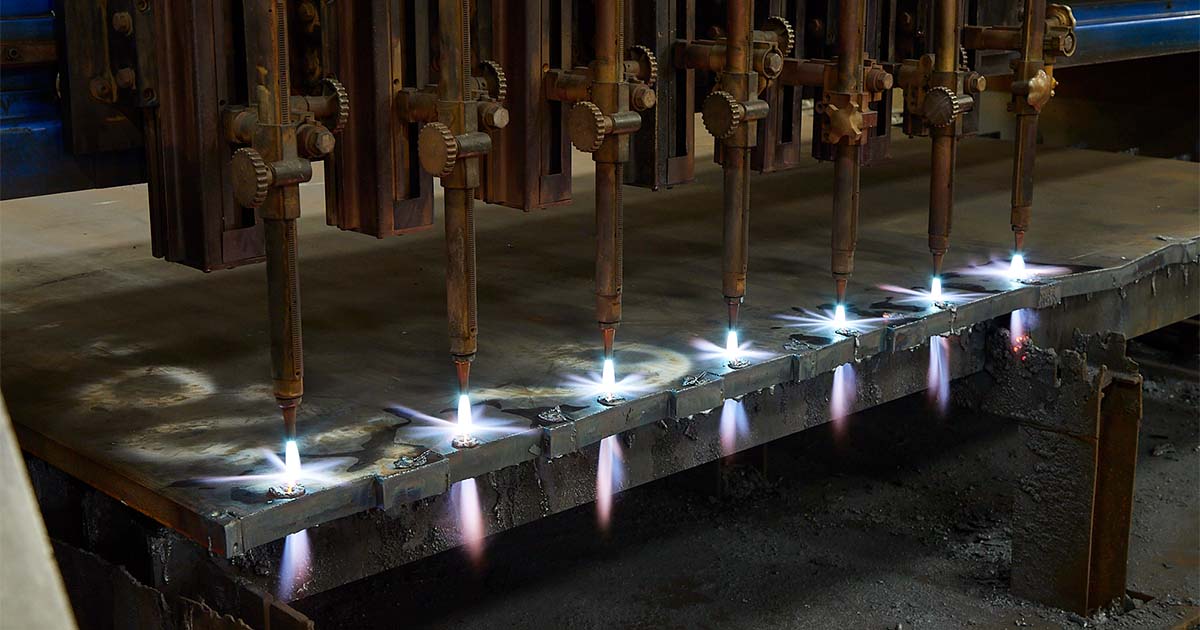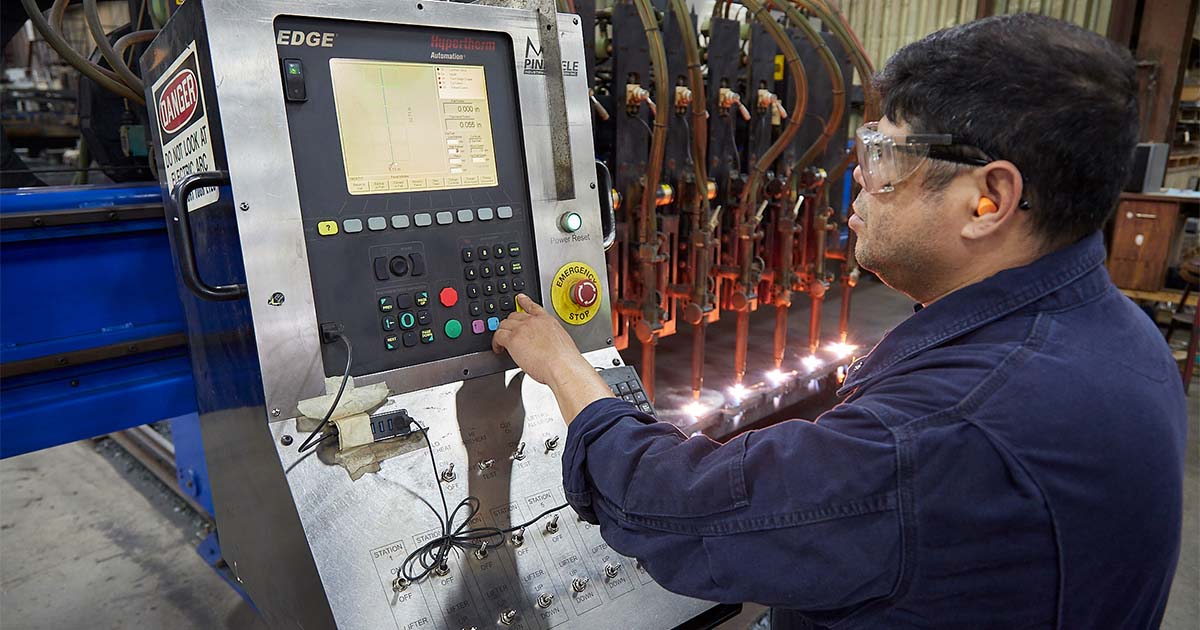
We collect basic website visitor information on this website and store it in cookies. We also utilize Google Analytics to track page view information to assist us in improving our website.
If you’re passionate about metal cutting or just keen to learn more, you’ve landed in the right place.
For over 38 years, Amber Steel has been at the forefront of metal cutting services, specializing in laser cutting, flame cutting, and plasma cutting. Our expertise has carved a niche in this cutting-edge industry, delivering precision and excellence across industrial projects big and small.
In our blog, we’ll share a mix of useful tips, innovative applications, our thoughts on sustainability in steel cutting, and more. Expect stories from the cutting floor, insights into how our processes can streamline projects across industries, and a few lessons we’ve learned along the way.
While we keep some of our trade secrets under wraps, this blog is designed to offer valuable nuggets of wisdom that you simply won't find anywhere else. Whether you’re a professional in the industry or someone fascinated by the possibilities of metal cutting, you'll find something of value here.
So, stick with us as we delve into the finer points of metal work. We’re glad to share our insights and lead discussions that matter to our industry.
How precision metal cutting propels the aerospace industry, from constructing lighter frames to enhancing aerodynamics.
The role of advanced metal cutting in automotive manufacturing, driving innovations in vehicle design and efficiency.
All about the robust and versatile process of flame cutting, ideal for tackling thicker metals with precision and ease.
Discover the art of crafting metal furniture, where cutting techniques meet design to create both functional and aesthetic pieces.
A behind-the-scenes look at the mechanics of metal cutting technologies and the science that makes them tick.
Laser cutting is where extreme precision meets efficiency, allowing for intricate designs and clean finishes.
The critical role of precise steel cutting in developing reliable and intricate medical devices.
How steel cutting supports the oil and gas industry with components that withstand extreme environments and pressures.
Known for its speed and versatility, plasma cutting slices through conductive metals with hot plasma.
Safety first! Tips and insights on maintaining a safe environment while handling powerful metal cutting equipment.
The backbone of construction, where steel fabrication and cutting technologies create frameworks that shape skylines.
Sustainability
A look at sustainability in metal cutting, focusing on practices that reduce waste and conserve energy to protect our planet.

Imagine using fire to create stunning artwork from metal. That's exactly what flame cutting is all about – a unique way to turn metal into beautiful sculptures using the power of fire.
Think of flame cutting as a creative mix between fire and metal in the world of art. Instead of fire being destructive, it becomes a tool for artists to shape metal into amazing designs. The intense heat of the fire acts like an artist's tool, shaping the metal into shapes that tell stories. When fire and metal come together, sculptures come to life with a mix of ancient craftsmanship and modern creativity.
Get ready to step into the artist's workshop, where fire and metal work together to make intricate sculptures. In the next sections, we'll explain the process, talk about what skilled artists think, and explore some advantages and challenges of the trade.
At Amber Steel, we specialize in laser, plasma and flame cutting, and have always been a "total source" service for the production of quality steel products. Quality is achieved by utilizing the right production technique for the right product. Our continual investment in equipment and technology enables us to offer clients many production alternatives to achieve exact product specifications and tolerances. If you’re interested in learning more about steel cutting or have a project in mind that you would need our expertise on, do not hesitate to reach out. We’re always one email or phone call away.
To truly appreciate the art of flame cutting, it's important to look back in time. Throughout history, artists have been drawn to the idea of using fire to shape metal into meaningful forms. From ancient civilizations to modern times, flame cutting has played a role in artistic expression. It's fascinating to see how this technique has evolved over the years and how artists from different cultures have used it to create unique pieces that still captivate us today.
What makes flame cutting so exciting for artists? Well, imagine working with two powerful elements – fire and metal. Fire has always held a certain fascination for humans, and when it comes together with metal, something magical happens. The combination of these two elements opens up a world of possibilities for artists to explore. It's not just about creating something visually stunning — it's about experiencing the energy and creativity that come from working with fire and shaping metal into art.
Have you ever looked at a sculpture and felt like it was alive? That's the kind of effect flame cutting can have on artwork. When artists use flame cutting, they're not just cutting metal. They're shaping it with fire. The flames leave behind marks and patterns that give each piece a unique texture and character. It's like the sculpture has a story to tell – a story of how fire danced across the metal and left its mark. This dynamic and organic element adds depth and emotion to sculptures, making them feel more connected to nature and the human touch.
When it comes to flame cutting for sculpture and artwork, having the right tools and materials is essential. Let's take a closer look at what's involved:
Oxy-fuel torch: This is the primary tool used for flame cutting. It combines oxygen and fuel gas to create a controlled flame that melts and cuts metal.
Cutting tips: Different tips are used to control the size and intensity of the flame, allowing for precision in the cutting process.
Gas cylinders: Oxygen and fuel gas cylinders provide the necessary gases for the torch to function.
Safety gear: Protective equipment like goggles, gloves, and flame-resistant clothing are crucial to ensure the artist's safety during the process.
Steel: Mild steel is commonly used for flame cutting due to its workability and affordability. Stainless steel and other alloys are also used for specific projects.
Copper: Copper's malleability and distinct colour make it a favoured choice for flame-cut sculptures.
Bronze: With its durability and artistic appeal, bronze is often chosen for sculptures that require intricate detailing.
Iron: Cast iron and wrought iron are used in flame cutting to achieve unique textures and effects.
Ventilation: Adequate ventilation is crucial when working with flames and gases to prevent the buildup of harmful fumes.
Fire extinguisher: Having a fire extinguisher on hand is essential to quickly control any unexpected fires.
Proper clothing: Flame-resistant clothing, leather gloves, and safety goggles protect against sparks and heat.
Clear workspace: Keep the workspace tidy to minimize the risk of accidents and ensure easy movement while working.
Training and experience: Artists should undergo proper training and gain experience before attempting flame cutting, as it involves working with potentially dangerous equipment.

Flame cutting is a multi-step process that involves careful preparation, precise execution, and creative finesse. Here's a closer look at how artists bring their sculptures to life through flame cutting:
Design and Planning: Artists begin by sketching their design on paper, envisioning how the final sculpture will look. This planning phase helps them visualize the shape and intricate details.
Metal Preparation: The chosen metal sheet is cleaned and marked according to the design. This ensures that the artist has a clear guide when cutting.
Workspace Setup: Artists create a safe and well-ventilated workspace. They arrange the necessary tools, including the oxy-fuel torch and gas cylinders, in a convenient and accessible manner.
Gas Adjustment: The appropriate gas mixture (oxygen and fuel gas) is adjusted based on the metal being used and the desired cut thickness.
Ignition and Preheating: The torch is ignited, and the flame is directed onto the metal's surface to preheat it. Preheating reduces the time needed for cutting and prevents distortion.
Cutting the Metal: With the metal preheated, artists begin the actual cutting process. The cutting tip is positioned at the starting point, and the torch is moved along the marked lines, creating a precise cut as the metal melts under the flame.
Controlled Movement: Maintaining a steady and controlled torch movement is key to achieving clean cuts. Artists adjust their hand movement and the torch's angle as needed for curved or intricate shapes.
Cooling and Finishing: After cutting, the metal is allowed to cool naturally or through controlled cooling methods to avoid warping. Once cooled, any rough edges or unwanted marks are smoothed out.
Metal Preparation: Artists ensure the metal is clean and free from contaminants that could affect the cutting process.
Workspace Setup: A clear and organized workspace prevents accidents and enhances efficiency. Adequate ventilation is maintained to disperse fumes.
Flame Cutting Equipment: Artists handle the oxy-fuel torch with care, making sure to follow safety guidelines. They maintain the correct gas pressure and adjust the flame as needed for different cuts.
Layering and Texture: Artists can vary the intensity and duration of the flame to create different textures on the metal, adding depth to the sculpture.
Gradual Cuts: Slow and controlled cutting motions allow for intricate detailing, such as curves and intricate patterns.
Negative Space: By strategically leaving areas uncut, artists can play with negative space, adding complexity to their designs.
From precision demands and safety concerns to the learning curve and material variability, flame cutting presents a range of obstacles that artists must overcome. Despite these challenges, the rewards are significant.
Precision Demands: Achieving intricate designs requires steady hands and precise torch control. Even small errors can affect the final result.
Metal Distortion: Intense heat during cutting can cause the metal to warp or bend, altering the intended shape.
Safety Concerns: Working with open flames and hot metal requires adherence to strict safety measures to prevent accidents.
Material Variability: Different metals react differently to flame cutting, requiring artists to adjust their approach based on the material's properties.
Technical Expertise: Learning the nuances of flame control, gas mixtures, and torch angles takes time and practice.
Trial and Error: Artists often go through a trial-and-error phase to understand how different metals respond to the flame and how to achieve desired results.
Skill Development: Mastering flame cutting requires practice and honing skills over time, gradually refining techniques.
Experimentation: Artists experiment with different torch movements, gas pressures, and metal temperatures to find the optimal settings for their specific projects.
Adaptation: Artists learn to adapt to unexpected challenges, like changes in metal behaviour or sudden torch malfunctions.
We hope this blog post helped you discover the artistry of flame cutting, where fire and metal unite to shape intricate sculptures, bridging history and innovation. This technique offers artists a dynamic means to express their creativity, infusing metal with life through the transformative dance of flames.
At Amber Steel, we specialize in laser, plasma and flame cutting, and have always been a "total source" service for the production of quality steel products. Quality is achieved by utilizing the right production technique for the right product. Our continual investment in equipment and technology enables us to offer clients many production alternatives to achieve exact product specifications and tolerances. If you’re interested in learning more about steel cutting or have a project in mind that you would need our expertise on, do not hesitate to reach out. We’re always one email or phone call away.